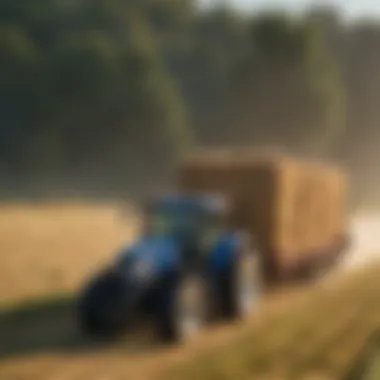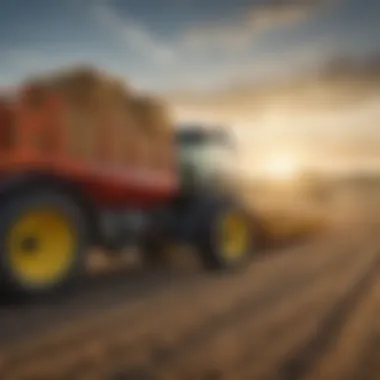Exploring the New Holland Bale Wagon: A Modern Marvel


Intro
The New Holland bale wagon represents a crucial innovation in the agricultural sector, addressing the complexities of hay and straw handling. As modern farming increasingly demands efficiency and precision, this machine offers a solution that enhances productivity while minimizing labor. This article will explore the functionality and features of the New Holland bale wagon, emphasizing its impact on contemporary agriculture.
Topic Overview
Definition and Importance
A bale wagon is designed specifically for transporting bales of hay or straw from the field to storage or feeding areas. This machinery not only streamlines the hay and straw handling process but also contributes significantly to the overall efficiency of farming operations. By reducing the time and labor needed for these tasks, farmers can focus on other essential activities, such as crop management and livestock care.
Brief History and Evolution
The evolution of bale wagons dates back several decades. Early models were often rudimentary, lacking the advanced features that today's machines possess. Over time, New Holland has pioneered numerous advancements, allowing for better load capacities, improved maneuverability, and enhanced safety features. These innovations have played a substantial role in the growth of efficient farming practices.
Key Techniques and Innovations
Sustainable Farming Practices
Adopting the New Holland bale wagon supports sustainable farming practices by promoting faster and more efficient harvesting methods. This not only reduces the carbon footprint associated with fuel consumption but also aids in timely planting of subsequent crops.
Advanced Agronomic Technologies
Integration of advanced agronomic technologies in newly developed bale wagons has led to improved functionality. For example, some models feature intelligent systems that can automatically adjust settings based on the load. This adaptation ensures that every bale is handled optimally, minimizing damage and wastage.
Practical Applications
Step-by-Step Guides
- Loading Bales: Position the wagon close to the bales. The loading arm or pickup should align with the bales.
- Securing the Load: Use the automated tensioning system to secure the bales firmly in place.
- Transporting: Drive the wagon carefully to the storage location, ensuring a steady pace to avoid shifting.
- Unloading: Once at the destination, use the unloading mechanism to safely deposit the bales.
Case Studies or Real-World Examples
Farmers who use the New Holland bale wagon report significant reductions in labor costs and time spent on hay handling. For instance, a farming operation in Iowa noted a 30% decrease in manual labor hours after integrating this machine into their workflow. Such results illustrate the transformative impact of the bale wagon in real-world applications.
"The efficiency of the New Holland bale wagon has allowed us to manage our time better, ultimately increasing our yield," mentions a farmer from Nebraska.
In summary, the New Holland bale wagon offers a comprehensive solution that addresses modern agricultural needs through its array of functionality and innovative design.
Preface to New Holland Bale Wagons
The New Holland bale wagon represents a significant advancement in agricultural machinery. Its efficient design and operational capabilities enhance the way hay and straw are managed in modern farming. Understanding the bale wagon's role is crucial for farmers looking to optimize their operations. This section will explore the pivotal aspects of New Holland bale wagons, considering their features and overall impact on agricultural efficiency.
Understanding the Bale Wagon's Role
Bale wagons serve a critical function in the collection and transport of bales. They reduce the physical effort needed to load and unload bales, allowing farmers to focus on other essential tasks. The New Holland bale wagon is designed to accommodate various bale types, making it versatile across different farming operations.
Farmers benefit from this machinery in numerous ways:
- Improved Efficiency: The speed at which bales can be transported increases productivity.
- Labor Reduction: Fewer hands are needed for moving bales, which is particularly beneficial during peak harvesting times.
- Safety Enhancements: Minimizing manual lifting reduces the risk of injury, a common concern in farming practices.
In essence, the New Holland bale wagon integrates seamlessly into farming routines, fundamentally transforming hay and straw management.
Historical Overview of Bale Wagons
The history of bale wagons traces back to the advent of mechanical farming in the early 20th century. Initially, manual labor was the primary method used for hay and straw handling. As agricultural needs grew, so did the search for innovative solutions that enhanced productivity.
New Holland has a longstanding reputation for developing advanced farming equipment. Their bale wagons evolved from simple designs to complex machines equipped with hydraulic systems and automated features. The progress in these wagons reflects broader trends in agricultural technology—aiming to increase efficiency, reduce labor, and improve crop handling.
The significance of historical developments in bale wagons is evident. They paved the way for modern designs, ensuring that contemporary farmers benefit from decades of innovation. Understanding this evolution offers valuable context for appreciating the New Holland bale wagon in today's agricultural landscape.
Key Features of the New Holland Bale Wagon
The New Holland Bale Wagon showcases several important features that streamline hay and straw handling in modern agriculture. Understanding these features helps farmers recognize how this equipment can significantly impact their operational efficiency. Whether it is related to construction, design aspects, or the types available, each element plays a vital role in enhancing productivity and reducing labor costs.
Construction and Design Aspects
The construction of New Holland Bale Wagons reflects durability and functionality. The use of high-quality materials results in a robust frame, ensuring the wagon can withstand heavy loads and harsh working conditions. These wagons often include galvanized steel components that resist corrosion, extending the life of the machinery. The design is tailored for optimal weight distribution, which contributes to better balance during transport.
A notable aspect of the design is the low-profile setup, allowing for easier loading and unloading. This can be crucial in tight working spaces often found on farms. Additionally, the height adjustments are user-friendly, enabling operators to adapt the wagon to different bale sizes effortlessly. Ultimately, the design is not merely aesthetic; it directly affects the wagon's overall performance and longevity.


Types of New Holland Bale Wagons
New Holland offers a variety of bale wagons tailored to different operational needs. This section covers two primary types: Single Bale Transport and Multi-Bale Transport.
Single Bale Transport
Single Bale Transport models are essential for farmers needing to move one bale at a time, particularly in smaller fields or where access is limited. This model's key characteristic is its compact size, which allows for precision handling. It remains a popular choice because of the ease with which it can navigate through narrow passageways and around obstacles in the field.
A unique feature of Single Bale Transport is its ability to stack bales individually with minimal risk of damage. This ability makes it advantageous for preserving the integrity of high-quality hay. However, while effective for small-scale operations or specific tasks, this model may lead to less efficiency in larger operations compared to multi-bale options.
Multi-Bale Transport
The Multi-Bale Transport models cater to larger farms or operations requiring the efficiency of moving several bales simultaneously. This model highlights its capability to handle multiple bales, drastically reducing the number of trips needed for transportation. Such efficiency is essential during peak harvesting seasons when time is of the essence.
A significant aspect of the Multi-Bale Transport is its enhanced capacity. This allows operators to load and transport several bales at once, improving productivity tremendously. However, the larger size may present challenges in navigation through tighter spaces. Farmers must consider this trade-off when selecting the right model for their needs.
"Choosing the right type of New Holland Bale Wagon can make a significant difference in operational efficiency and ease of use in varying conditions."
Operational Efficiency
Operational efficiency is a pivotal aspect of the New Holland bale wagon, influencing its overall effectiveness on agricultural operations. Such wagons operate in various conditions and are crucial for both hay and straw management. Efficiency encompasses several critical elements, such as loading and unloading mechanisms, time savings, and labor reduction. Understanding these factors helps farmers appreciate how a bale wagon can streamline their workflow, reduce operational costs, and enhance productivity.
Loading and Unloading Mechanisms
The loading and unloading mechanisms of New Holland bale wagons are designed with practicality and user-friendliness in mind. Most models feature hydraulic systems that enable swift loading of bales onto the wagon, minimizing the time spent on this critical task. The hydraulic action allows for precise control, ensuring that bales are placed securely without the risk of tipping or falling. This feature reduces the physical effort required by operators.
During unloading, the design often allows for the quick release of bales, either onto the ground or into a storage area, depending on the needs of the operation. The ease of removal is particularly valuable during busy harvest periods when timely bale management is crucial. By utilizing robust yet straightforward systems for these processes, operators can maintain a steady workflow, which is vital for modern farms.
Time and Labor Savings
Time and labor savings generated by the New Holland bale wagon cannot be overstated. Traditional methods of fetching and transporting bales can be arduous and require a significant labor force. However, with the introduction of these advanced machines, farmers often find that they can complete tasks in a fraction of the time.
For example, when using a bale wagon, the process of transporting multiple bales at once reduces the number of trips needed. This capability alone can lead to a notable decrease in fuel costs and vehicle wear and tear. Moreover, farmers can deploy their labor more effectively; instead of spending hours manually loading and unloading, they can allocate resources to other essential farming activities.
"Operational efficiency in bale handling is not merely about speed but also about maximizing productivity without compromising quality."
In summary, the loading and unloading technologies of New Holland bale wagons significantly enhance operational efficiency, and the time and labor savings they provide further underscore their value in contemporary agriculture. Investing in a bale wagon can lead to smarter farm management and increased overall productivity.
Technical Specifications
Understanding the technical specifications of the New Holland bale wagon is crucial for farmers and agricultural professionals. These specifications provide insight into the wagon's capabilities, which directly influence its operational effectiveness and suitability for diverse farming tasks. Knowledge of these details can help users make informed decisions while optimizing their hay and straw handling processes.
Dimensions and Capacity
The dimensions of the New Holland bale wagon play a significant role in both storage and transport. The size can impact the number of bales the wagon can carry, ultimately affecting efficiency in field operations. For example, wagons can vary in length, width, and height, with many models accommodating up to 15 bales per load, depending on bale size and type.
- Length: Typically ranges from 20 to 30 feet.
- Width: Generally around 8 feet for stability during transport.
- Height: Usually about 4 to 5 feet, allowing for easy loading and unloading.
These dimensions allow the New Holland bale wagon to efficiently operate in narrow fields and make turns without compromising stability. Additionally, the capacity is a crucial element. A higher capacity means fewer trips are needed to transport bales from the field to storage. This feature enhances productivity and saves time and labor.
Power Requirements
The power requirements for the New Holland bale wagon strongly determine its functionality. The wagon's operational efficiency relies on the correct pairing with a tractor, which must provide adequate horsepower and torque. Generally, the recommended power ranges from 60 to 90 horsepower depending on the specific model.
- Horsepower Requirement: As mentioned, between 60 and 90 HP is standard for optimal performance.
- Hydraulic Needs: Many models operate hydraulic systems for loading and unloading, requiring a compatible hydraulic flow rate.
Selecting the right power source ensures effective performance during intensive tasks. A tractor with insufficient power can lead to increased fuel consumption and potential mechanical stress on the wagon itself. Therefore, understanding these specifications helps in maximizing both productivity and durability.
User Experience and Assessments
User experience is a vital aspect when evaluating the New Holland bale wagon. It encompasses how users interact with the machine and the benefits derived from its functions. Farmers and agricultural professionals often seek equipment that simplifies their tasks and maximizes efficiency. User assessments help to gauge this effectiveness in the real world. By focusing on this topic, we can better understand how the New Holland bale wagon meets the demands of modern agriculture. Additionally, it offers insights into the tangible advantages experienced by those who operate these machines.
User Reviews and Testimonials
User reviews provide firsthand insights into the New Holland bale wagon's efficiency and performance. Many farmers appreciate its user-friendly design, which simplifies the operation and reduces the learning curve for new users. Here are a few common themes from reviews:
- Ease of Use: Users often highlight how intuitive the controls are, making it easier to load and unload bales efficiently.
- Durability: Farmers note that the construction of the New Holland bale wagon withstands harsh conditions, ensuring it lasts across multiple seasons.
- Efficiency in Load Capacity: Many operators report that the wagon can handle a substantial number of bales in one load, reducing the number of trips needed.
"The New Holland bale wagon transformed my work routine. I can now move bales quicker and with less effort," expressed one satisfied user.


These testimonials represent a collective sentiment, showing that it effectively meets the needs of various types of farms.
Comparative Analysis with Competitors
When assessing the New Holland bale wagon, it is essential to compare it against its competitors in the market. Major competitors include equipment from brands like John Deere and Case IH. This analysis can bring key features into focus:
- Performance: New Holland models often outperform others in terms of speed and loading capability.
- Technology: The incorporation of smart features in newer models sets New Holland apart, offering advantages like data integration that others lack.
- Cost Efficiency: While prices may vary, the value of time saved in operations often provides a compelling reason for investment in New Holland compared to other options.
In summary, user experience assessments and comparative analyses provide a clear picture of New Holland bale wagons. They highlight the equipment's strengths and how it fits into modern farming practices. Understanding user feedback and analyzing competitors' features can guide farmers in making informed decisions.
Maintenance and Longevity
In the context of New Holland bale wagons, maintenance and longevity are critical factors that can significantly influence overall productivity in agriculture. Proper maintenance not only enhances the lifespan of the equipment but also ensures efficient operation during peak farming seasons. This section will delve into the essential maintenance practices and the considerations surrounding the durability and parts replacement of these machines.
Routine Maintenance Practices
Routine maintenance is essential for any farm equipment, and the New Holland bale wagon is no exception. Regular checks and servicing help to identify potential issues before they escalate into costly repairs. Essential routine maintenance practices include:
- Daily Inspections: Farmers should perform daily checks before operating the wagon. This includes examining hydraulic systems, tires, and connections.
- Lubrication: Keeping the moving parts well-lubricated is crucial. Only a small amount of oil can prevent wear and tear.
- Cleaning: After a day’s work, the wagon should be cleaned. Hay debris can accumulate and cause mechanical problems if left unattended.
- Hydraulic Maintenance: Inspect hoses and fittings for any leaks. Maintaining the hydraulic system ensures smooth operations.
- Tire Health: Regularly inspect tire pressure and tread. Properly inflated and maintained tires improve handling and reduce fuel consumption.
These practices not only help in maintaining the machine’s efficiency but also instill a sense of care toward the investment made in such essential equipment.
Durability and Parts Replacement
Durability is one of the hallmark qualities of New Holland bale wagons. Constructed with high-quality materials, these machines are designed to withstand the rigors of farm life. However, like any machinery, certain parts may require replacement over time. Key considerations include:
- Identifying Wear and Tear: Components such as belts, chains, and bearings experience wear and may need replacement. Regular checks can help in preemptively addressing these parts before they fail.
- Aftermarket Parts: Farmers can choose to use OEM (Original Equipment Manufacturer) parts or aftermarket options. While OEM parts tend to be pricier, they ensure compatibility and maintain warranty. On the other hand, aftermarket parts can offer cost savings but may vary in quality.
- Using Quality Supplies: Investing in high-quality compression springs, hydraulic cylinders, and other critical components will enhance the working life of the bale wagon.
"A proactive approach to maintenance not only ensures longevity but also optimizes the overall performance of the New Holland bale wagon."
Understanding these aspects allows farmers to maximize their equipment's effectiveness while minimizing downtime and unexpected expenses. By following solid maintenance practices and being attentive to parts replacement, users of New Holland bale wagons can ensure that their equipment remains an asset for years to come.
Technological Innovations in Bale Wagons
Technological innovations have dramatically changed the landscape of agricultural equipment, and esto es especially true for bale wagons. As farmers face increasing pressure to maximize efficiency and productivity, technological advancements such as integration with farm management software and automation are providing significant benefits. These innovations not only streamline operations but also enhance the overall performance of the equipment, making it more indispensable for modern agriculture.
Integration with Farm Management Software
The integration of bale wagons with farm management software is reshaping how farmers handle hay and straw. This software often helps in tracking loads, scheduling operations, and managing inventory. When a bale wagon is connected to farm management systems, farmers can receive real-time data on their operations. This connectivity enables them to make informed decisions and adjustments during the workday.
For example, a farmer can monitor the number of bales loaded or unloaded at any given time, reducing the chances of overloading. This precise data can also assist in planning future operations, thereby optimizing the workflow on the farm. The synergy between equipment and software leads to more organized tasks and improved record-keeping.
Automation and Smart Features
Automation in bale wagons is increasingly seen as a game changer for farmers. These machines now come equipped with smart features that automate various tasks, significantly reducing manual labor. For instance, automated loading and unloading systems make the process faster and safer. Farmers can now focus on other critical aspects of their operations while the machinery handles the bulk of the work.
Moreover, smart sensors and monitoring systems are crucial for ensuring proper function and maintenance. These sensors can provide alerts if there are any malfunctions, allowing farmers to take preemptive measures and avoid downtime.
In summary, technological innovations in bale wagons encompass both integrated farm management solutions and automation. These features enhance efficiency and productivity while reducing labor costs. Adopting such technologies will likely become more prevalent as farmers strive to improve their operations in an increasingly competitive environment.
"The adoption of technology in agriculture is no longer optional. It is a matter of survival." - Anonymous
As the industry evolves, bale wagons equipped with these innovations will be at the forefront, shaping the future of agricultural practices.
Environmental Considerations
The environmental impact of agricultural machinery is an increasingly relevant issue in today’s farming landscape. The New Holland bale wagon embodies significant advancements that align with modern sustainable practices, acknowledging the interconnectedness of agriculture and environmental stewardship. Understanding its environmental considerations is paramount for farmers and agricultural enthusiasts looking to adopt equipment that is not only efficient but also bears minimal ecological impact.
Sustainable Practices in Bale Handling
Sustainable practices in bale handling revolve around minimizing waste and optimizing resource use. New Holland bale wagons integrate features that facilitate effective handling of hay and straw while ensuring minimal disturbance to the environment. This equipment is designed to enhance the efficiency of the collection and transportation processes.
Utilizing a bale wagon reduces the need for multiple trips with smaller vehicles. This means lower fuel consumption and reduced greenhouse gas emissions. Furthermore, the design of these wagons allows for an organized arrangement of bales, reducing the risk of spoilage and ensuring the quality of stored fodder is maintained.
- Efficient Loading Mechanisms: The automation and hydraulic systems of the bale wagon provide quick loading, decreasing time in the field and reducing fuel consumption.
- Proper Bale Arrangement: By ensuring bales are stacked securely, the risk of damage during transportation decreases, further preventing waste.
Incorporating these sustainable practices not only benefits farmers economically but also contributes positively to environmental health. The potential for reducing soil erosion through careful handling can lead to improved land conditions over time.
Impact on Soil and Crop Health


The direct influence of bale handling practices on soil and crop health is significant. The New Holland bale wagon’s operational benefits provide a ripple effect on the agricultural ecosystem. When bales are handled correctly, it helps maintain the integrity of the soil.
Practices that minimize soil compaction, such as field traffic management with a well-designed bale wagon, can promote healthier root growth and enhance the soil structure. Additional factors include:
- Soil Erosion Prevention: By transporting bales efficiently, the risk of soil erosion is mitigated. Excessive traffic by heavy equipment can compact soil and lead to erosion.
- Crop Sustainability: Properly managed bales ensure that leftover materials such as straw remain on the fields, enhancing soil organic matter. This provides essential nutrients to future crops.
"Effective bale handling is crucial for ensuring the long-term health of both crops and soil, influencing future yield potential."
Understanding these environmental considerations equips farmers with knowledge on how to choose and utilize bale wagons to promote a sustainable future in agriculture. The New Holland bale wagon stands as a significant contributor to responsible agricultural practices, marrying technology with environmentally conscious efforts.
Economic Implications
The economic implications of using the New Holland bale wagon are multifaceted, directly affecting farm profitability and operational effectiveness. Understanding these implications is key for farmers considering the investment into this technology. The analysis of costs and potential returns can aid in making informed decisions that align with agricultural objectives.
Cost Analysis for Purchase and Operation
When evaluating the New Holland bale wagon, it is essential to consider the full spectrum of costs involved.
- Initial Investment: The upfront cost of a New Holland bale wagon varies based on the model and specifications. Prices generally range in tens of thousands of dollars. Farmers need to account for this expenditure as part of their capital investment.
- Operating Costs: Ongoing expenses should also be factored in. This includes fuel consumption, maintenance, and necessary repairs. Regular maintenance is crucial to ensure longevity and efficiency, leading to predictable, yet variable costs over time.
- Workforce Considerations: Utilizing a bale wagon can alter labor needs. Though it may require skilled operators, it can reduce the total number of hours workers spend on hay handling. This shift can lead to decreased labor costs, a significant component of overall farm expenses.
- Financing Options: Farmers might explore financing options, including loans or leasing agreements. A thorough cost-benefit analysis should encompass interest rates and terms to find the most economically sound route.
"Investing in modern equipment like the New Holland bale wagon can seem high at first, but the long-term savings often outweigh the initial costs."
Return on Investment for Farmers
The return on investment (ROI) for farmers using the New Holland bale wagon presents a compelling argument for upgrading from traditional methods.
- Increased Efficiency: The primary advantage is the increased efficiency in handling bales. Speedier loading and unloading processes not only save time but also enable farmers to complete tasks sooner, freeing up time for other important farm operations.
- Reduced Labor Costs: With fewer workers needed for handling hay, farmers can significantly cut labor costs. This impact on workforce size can lead to substantial savings over time, enhancing overall profitability.
- Higher Quality Produce: Proper handling of bales can lead to better quality hay, which can command higher prices on the market. A bale wagon minimizes damage during transportation, leading to a better product when sold.
- Market Responsiveness: The ability to move bales quickly allows for more responsive market actions. Farmers can sell their hay when prices are favorable, maximizing profits.
Considering all these factors, a thorough understanding of the economic implications of investing in a New Holland bale wagon is crucial. It provides overall clarity and assists in strategic decision-making for improving efficiencies, reducing costs, and ultimately enhancing the profitability of farming operations.
Case Studies and Real-World Applications
The examination of case studies and real-world applications of the New Holland bale wagon offers valuable insights into its functionality and effectiveness in various agricultural settings. This section highlights the practical experiences of farmers who have integrated these machines into their operations. Understanding these real-life examples is crucial. They provide a practical context that illustrates how the bale wagon can optimize workflows and enhance productivity in hay and straw handling.
Success Stories from Farmers
Numerous farmers have shared positive experiences with the New Holland bale wagon, citing its efficiency and time-saving capabilities. One farmer in Iowa stated that since they began using the New Holland BR7050 round baler in conjunction with their bale wagon, they reduced the time taken to gather bales from the field by approximately 35%. This significant increase in efficiency allows them to allocate more hours to other essential farm activities.
Another farmer in Pennsylvania reported that the wagon handled their mixed grass and alfalfa bales with ease. They appreciated the capacity of the New Holland bale wagon to transport multi-bale racks, which facilitated quicker movement from the pastures to storage facilities. As a result, the farmer noted an improvement in the quality of the stored bales, attributing this to minimized exposure to the elements during transport.
Farmers also highlight the adaptability of New Holland bale wagons in various terrain conditions and their compatibility with other New Holland equipment. This integrated approach fosters a streamlined workflow that benefits overall farm operations.
Challenges Faced and Solutions Implemented
While the New Holland bale wagon boasts many advantages, some farmers have encountered challenges. One common issue is the learning curve associated with the automation features integrated into newer models. Farmers transitioning from manual bale handling often experience initial difficulty in mastering the automated load and unload mechanisms.
To overcome this, several farmers participated in training sessions provided by local dealers. These sessions equipped them with the necessary knowledge to utilize the equipment effectively, significantly easing the transition process. Additionally, user manuals and online forums such as reddit.com have proven beneficial for troubleshooting and advice.
Another challenge includes maintaining the machine’s performance. Some farmers initially faced issues with parts wear, particularly in high-use environments. However, proactive maintenance and the use of proper lubrification protocols significantly improved machine lifespan and reliability. Farmers are now more conscious of routine check-ups, emphasizing the need for periodic inspection to avoid unexpected downtimes.
Future Directions in Bale Wagon Technology
Future directions in bale wagon technology are crucial to understand as they will shape the way hay and straw handling is managed in modern agriculture. With constant advancements in machinery, the efficiency and productivity of farming operations can improve significantly. New Holland, being one of the leaders in agricultural equipment, is expected to introduce innovations that not only enhance functionality but also align with sustainable practices. These advancements are relevant not only for current farmers but also for future generations who will rely on these machines to meet growing agricultural demands.
Predicted Trends in Equipment Innovation
Several trends are emerging in the technology surrounding bale wagons which can redefine agricultural practices.
- Smart Technology Integration: Farmers can expect more integration of smart technology in bale wagons. This means features such as GPS tracking, automated loading systems, and real-time data collection will be standard. Such enhancements aim to make operations more efficient.
- User-Friendly Interfaces: As technology evolves, so too does the importance of user interfaces. New Holland is likely to focus on creating systems that are intuitive and require less time for training. Simplicity remains a key element.
- Sustainability Focus: There is a growing emphasis on sustainability. Innovations may include energy-efficient engines and the use of recyclable materials in construction. These transformations support the industry's goal of reducing environmental impact.
- Increased Capacity and Performance: Future models are expected to be designed for greater capacity—allowing farmers to handle more bales at once without sacrificing performance. This includes improved hydraulic systems and enhanced power-to-weight ratios.
"Technology in agriculture is not just about equipment; it’s about ensuring the resilience of the entire farming ecosystem."
Potential for Industry Growth
The potential for industry growth in bale wagon technology is significant and multifaceted.
- Increased Demand: As global population grows, so does the need for efficient food production. Bale wagons that utilize advanced technology will find a larger market share as farmers seek to optimize operations.
- Innovations Driving New Markets: New Holland's ongoing commitment to innovation may unlock new markets for their products. Equipment that integrates automation may attract tech-savvy farmers.
- Collaboration with AgTech Companies: Collaborating with ag-tech companies can further stimulate growth. Innovations in data analytics and farm management software can enhance the functionality of bale wagons, making them an indispensable asset on the field.
- Education and Training: Investing in education about these advancements ensures the successful transition for farmers. Workshops and training programs focused on new technology will be necessary to ease the learning curve.
Ending
The importance of the conclusion section in this article lies in its ability to synthesize the diverse aspects of the New Holland bale wagon. This piece of equipment serves as a critical component in modern agricultural practices. By summarizing the key insights, it reinforces how the bale wagon enhances efficiency and productivity in hay and straw handling.
Through our discussions, we uncover the functional capabilities and unique features that make this machine invaluable for farmers and agricultural enthusiasts alike. The operational efficiency it brings cannot be overstated. Savings in time and labor not only benefit individual farms but contribute to the overall productivity of the agricultural sector.
Furthermore, considerations such as maintenance practices and technological advancements provide crucial insights for optimizing usage. Recognizing these elements allows farmers to make informed decisions regarding their investments. The New Holland bale wagon exemplifies how agricultural machinery can evolve to meet farmers' needs while promoting sustainability and efficiency.
Overall, the examination of the New Holland bale wagon presents a compelling case for its place in contemporary agriculture. It is not just a tool; it is a facilitator of modern farming practices, enhancing productivity and operational capacity. This conclusion serves to invite further exploration and consideration of the bale wagon's benefits in everyday farming operations.



